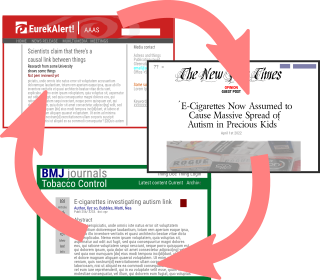| class | embellishments |
| category | noble cause corruption |
| motivation | grants, publish or perish |
| cred impact | 🟥/🟪/🟫 |

PR studies
All research is affected by preconceived notions. Some methodologies are meant to avert them. It remains unrealistic to prevent all cognitive biases. Which is why academia often prefers ambigious phrasing and super reserved language. Most anyway.
Tobacco control is particular in that not all slants and proclamations are accidental. The diversion between papers and floated press releases is sometimes planned for. It exploits the news medias` dependence on spectacle over balance.
- The association between exaggeration in health related science news and academic press releases: retrospective observational study
- Analysis of common methodological flaws in the highest cited e-cigarette epidemiology research
- Impact factor manipulation across academic journals…
- The spread of true and false news online
progression of slant
Most research funding comes attached with strings. Some more than others. Bloomberg no less than tobacco industry grants. The disingenuity doesn't stem from the topic focus, but how it gets slanted in press releases.
Papers are often cautious with "associated with" or walking the hypothesis back in the limitations section. But when the same authors then write and agree to summaries in EurekAlert, phrases like "might" and "could" or even "causing" and "leading to" are not uncommon. And this is how journalists often get tricked. The appearance of officiality and appeal to authority, paired with time pressures, often lead to media outbursts on ventured vaping risks.
notable sources
Institutions should generally take a hands-off approach to not hogtie academic freedom. Which however does not mean that blatant FUD should go unnoticed by internal peer review or oversight boards. Some orgs have aquired a bit of a reputation:
| unversity | perception |
|---|---|
| University of California (UCSD+UCSF) | 🟥🟥🟥 |
| Johns Hopkins BSoPH | 🟥🟥🟫 |
| University of Bath | 🟥🟪 |
Important: Should not disparage all researchers. But journalists should be aware of the slant frequency. (It's largely a failure of the journals, of course. You can't just play oblivious to accompanying press notes.)
Awareness of Wakefield-style "science per press conference" has clearly waned.
other references
- Tobacco harm reduction as a path to restore trust in tobacco control
- Retractions in the scientific literature: Do authors deliberately commit research fraud?
- Beautification of data: "It is the intentional nature and the repetition of these "arrangements" that are the real switch to deliberate fraud"
- Balancing consideration of the risks and benefits of e-cigarettes
- Professional disruption in health regulation: electronic cigarettes in the European Union touches on legitamization rationales (epistemic arbitrage)
- Some endeavour at remedying:
- Vape wars: The fierce debate over the banning (and unbanning) of Juul e-cigarettes
- Media bias out of potential anticipatory obedience
- Using Moralization as a Persuasion Strategy in Public Health Messages: A Cross-Sectional, Experimental Study on Vaping
- Withholding differential risk information on legal consumer nicotine/tobacco products: The public health ethics of health information quarantines
- A tale of flawed e-cigarette research undetected by defective peer review process
- Motivators:
- The spread of true and false news online
- A Taxonomy of Non-honesty in Public Health Communication
- Sourcing embargos by FDA CTP - the very def of access journalism
- SNW:Information_manipulation
- Improving researchers’ conflict of interest declarations